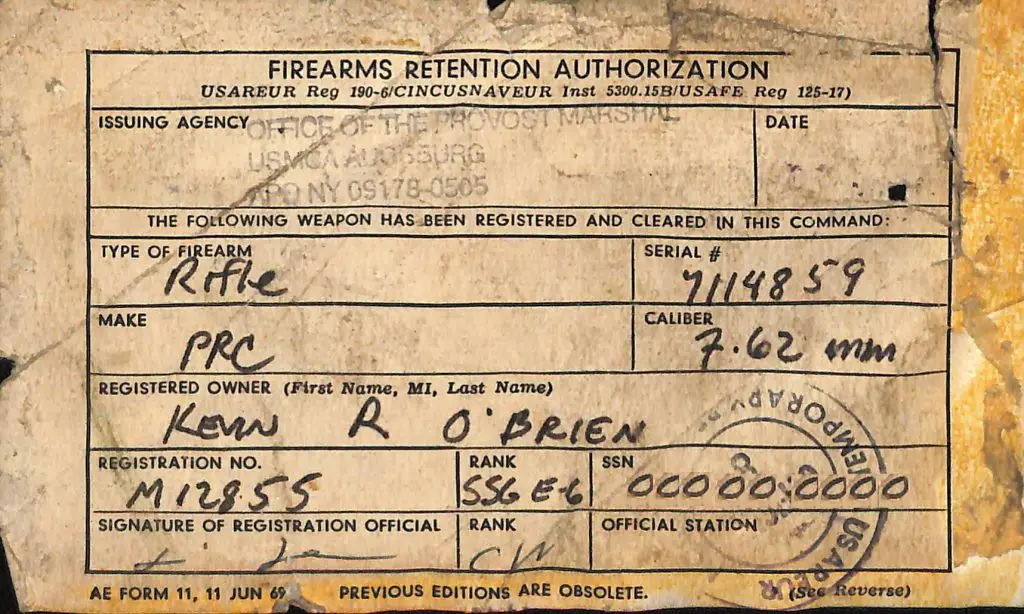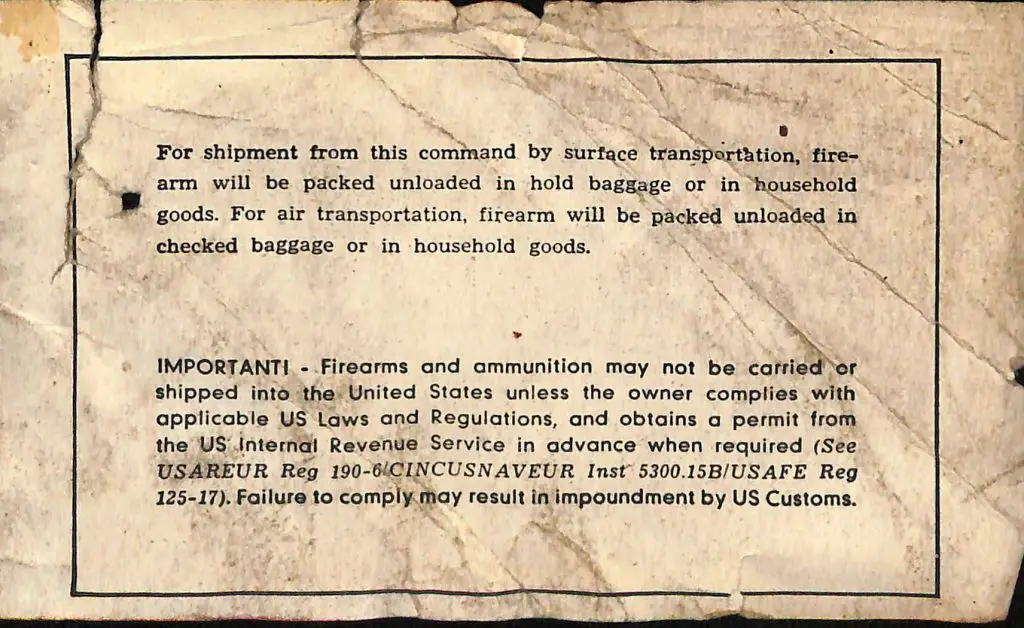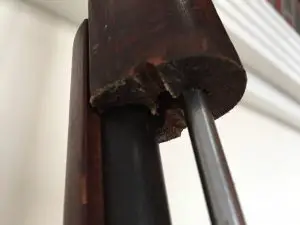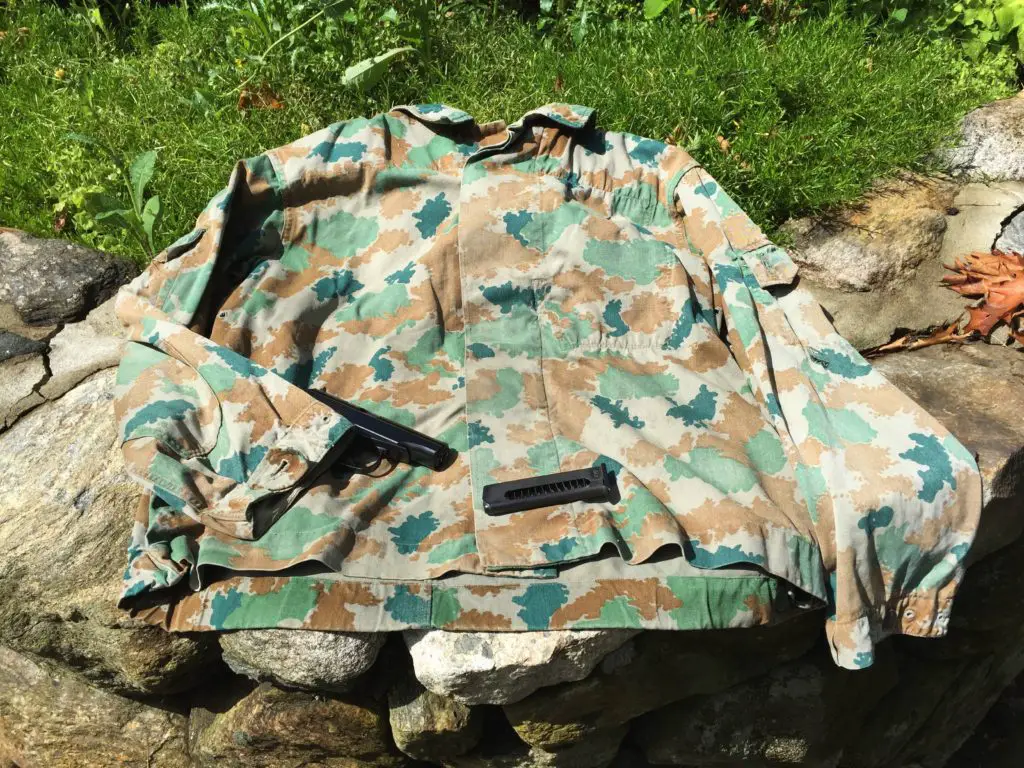Here’s something that some of you have seen a lot of, and others have never seen: a Firearms Retention Authorization, AE Form 11, 11 JUN 69. What it is, is a “weapons card” for privately owned weapons stored in a unit arms room.
Why store weapons there? If you were a single soldier — and Your Humble Blogger was disconnecting from Plaintiff I at the creation of this card, in 1985 — you weren’t allowed to keep your guns with you. Under US Army Europe regulations — that is what the “AE” means — promulgated by the extremely anti-gun provost marshals, you had to store them in the arms room.
Gun owners hated this: it was a lead-pipe guarantee that your guns would be poorly stored, exposed to rust-inducing environments, given the gefingerpoken by anyone who had business (or a buddy) in the Arms Room, and sometimes, as happened to me at Goodfellow Air Force Base in Texas in 1980, shot with corrosive ammunition by some armorer buddy, and then not cleaned, destroying bores.
But armorers hated this: even, indeed, especially, those armorers who were all on the up-and-up and who wouldn’t abuse your firearms. They had their hands full doing stuff with the unit’s real weapons, like issuing them out for half the troops to fail annual qualification. (They always passed, afterwards — on paper) and trying to get the Unique and Special Snowflakes® of MI to actually clean the things afterward… not to mention monthly inventories, change of command inventories, Technical Inspection and maintenance turn-in of weapons, managing the constant personnel turmoil as disaffected soldiers left at tour- or enlistment-end and replacements came in, and they had to do it with cramped arms rooms.
Some staff sergeant showing up with two or three dozen weapons and an SF chip on his shoulder did not please the armorer, who had to book in all the hardware, find a place to store it, and listen to the sergeant complain about how previous armorers had treated the guns.
“What do you need all this [deleted] for, anyway? Nobody wants this [deleted].” After all, each of the guns needed an entry in the book, a place to be locked up, and, on exit, one of these cards went with it to prove that the t’s had been dotted and the eyes had been crossed in conformity with Army Europe writ. The Germans may have lost the war, but their Prussian rechthaberisch tendencies managed to infiltrate and undermine the Provost Marshals’ Offices. Jawohl!
This particular example records the storage of one “PRC Rifle” serial number 7114859 in the arms room of the 501st MI Battalion in Augsburg, Germany, from 1985-87. (Why was an SF guy sentenced to that place? Because he had been an MI guy before going SF. You see, MI’s personnel management was so bad that they were perennially shorthanded, and until SF Branch existed, to defend its people, no one could prevent that kind of involuntary “levy,” or transfer). For most guys, the levy came to some thankless task like recruiter or drill sergeant duty. (Although most of the guys who did drill sergeant duty came to enjoy it, even while counting the days to end of tour). But this MI assignment was horrible, the leadership rotten, the work a waste of time. We did get to improve several European languages and enjoy many aspects of assignment to Germany.
At the end of the tour, each firearm being imported into the United States had to have one of these, and either proof that it came from the USA in the first place, or an approved ATF Form 6. There are entire units of Customs MPs who do nothing but inspect personnel and their stuff, and, from what we’ve seen, help themselves to what they can.
The card still bears the marks where it was taped to the buttstock of the firearm. (We had been advised to do that to prevent the MPs “losing” the card and helping themselves to firearms). The rifle was a Chinese Type 56 SKS, one of two in Your Humble Blogger’s household goods going to and from Mitteleuropa, and at the time of acquisition something of a rarity in American hands. (Soon they would be common as grains of sand). Indeed, the initial card was drafted, “Chinese Type 56,” and the armorer wanted the cards all redone as “rifle” and “pistol” to simplify his logging them in. But the rifle itself is interesting, and if it’s the one we’re thinking of, has a great apocryphal story. Perhaps it and its SKS brother should be featured Thing From The Vault sometime.
What’s a Duffle Bag Cut?
It never occurred to us until recently that there were people in the gun culture unfamiliar with the Duffle Bag Cut, until a knowledgeable young gun guy asked us, “What’s a Duffle Bag Cut?” as we described such a cut on a Mauser that Santa brought us this year.
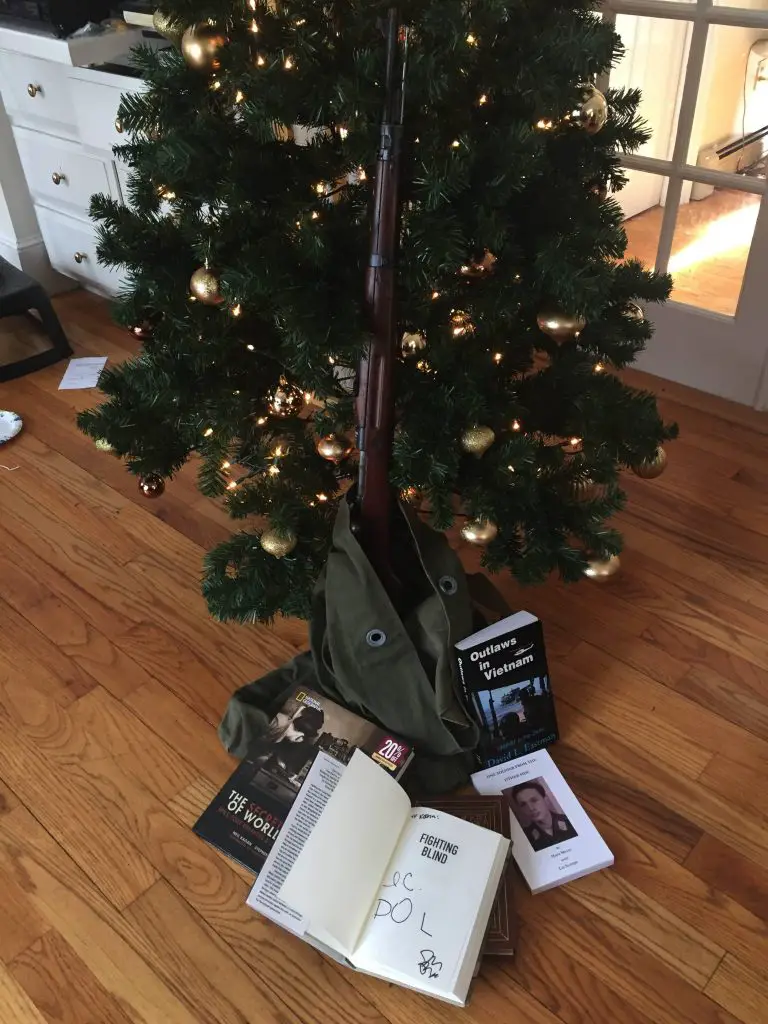
Some of the WeaponsMan related Christmas stuff, posing at the tree. The cut doesn’t show with the rifle at rest.
Thing is, if you grew up in collecting in the 50s, 60s or 70s, many WWI and WWII vintage long guns had this cut, and everybody knew why.
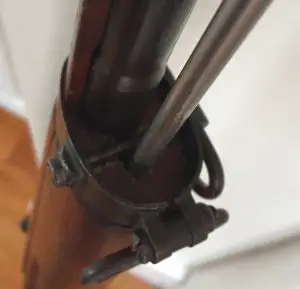
Rear side of the cut, which was done with the stock off the gun. The dual sling swivels (left side for cavalry, bottom for infantry) was often seen on Czech long arms like this early 7.92 mm vz.24.
But circumstances have changed, a lot. The military, especially the military police and the judge advocates, have fallen under the sway of gun control activists, and the guys are no longer permitted to take and keep war trophies.
Taking an enemy firearm as a trophy was widespread (and even encouraged, or at least permitted) in World War I and II and the Korean War. It came under some restrictions in Vietnam, and by the GWOT was totally and utterly banned.
But during its heyday in the 20th Century, war trophy taking was a norm. The weapons were brought back by the frontline troops who took them, the rear-echelon troops who traded for them, and the MPs who confiscated them for their own personal benefit, which was definitely a thing, if you listened to the WWII guys when they were still around to talk.
There was a problem, though. A Mauser or Arisaka didn’t fit in a GI duffel bag (and often, all a troop had for luggage was a duffle bag and a field pack). Enter the Duffle Bag Cut. Someone would cut the stock where the cut would be hidden by the barrel band.
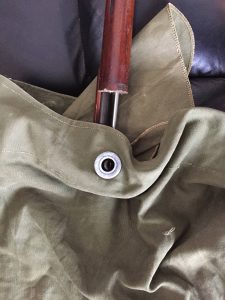
This WWII bringback in a genuine WWII duffle bag (late Great Uncle Ovide’s) shows how the cut made it possible to close the bag on a disassembled Mauser, where even the bare stock would have been several inches too long. .
A permanent alteration to a firearm usually gets collectors all wound up, but this cut now a 70-year-old marker, an authentic part of the gun’s history and the tale it would tell if it could talk. Under the barrel band, it doesn’t hurt the utility of the gun for display, and so few collectors would consider repairing the cut (although any gunsmith not of the Wile E. Coyote School of Gunsmithing could). Those WWII soldiers who brought back Mausers and Arisakas, etc., were looking to keep them as trophies, or have them sporterized as deer guns, and the last few inches of the wood was not of any use on a sporting rifle.
A Duffle Bag Cut should not be seen on a gun with import marks. Instead, it’s the second-best indicator (after military capture or bringback papers) of a GI bringback. And it’s just one more interesting little thing about our Christmas VZ.24 Mauser.
(Note: We were expecting to put the 3rd Part of our M16A2 paper analysis up at this point, but have delayed and delayed and fiddled, waiting for a resource that has been unavailable; should we get our mitts on it again, we’ll have the post Monday morning. We regret the delay. -Ed.)
Footlocker Find: East German Camo Jacket
One good East German deserves another, so the jacket is displayed here with an Ernst Thällmann Werke Pistole Makarow, as the Russian-designed DA autopistol was termed in the soi-disant “German Democratic Republic,” which was neither German nor Democratic, and was only a Republic when considered as opposed to a Monarchy.
From about 1949 to 1990, the Deutsche Demokratische Republik was a sort of Potemkin state structure set up under Soviet authority in the Soviet Occupation Zone of Germany. The politicians leading it at the outset were lower-level German Comintern functionaries, loyal to Moscow. Many of them spent the war years in Russia working on Soviet propaganda in the German language or as political officers in units of German “volunteers” from the prison camps. A state needs an Army, so these Soviet-controlled Germans quickly stood up an Army in the Red Army mold, with, originally, Russian weapons and equipment. It was called the NVA: Nationale Volksarmee, National People’s Army. (Where the “people” came in, is they got taxed to support it and drafted to fill its ranks. The officers were all Soviet yes-men).
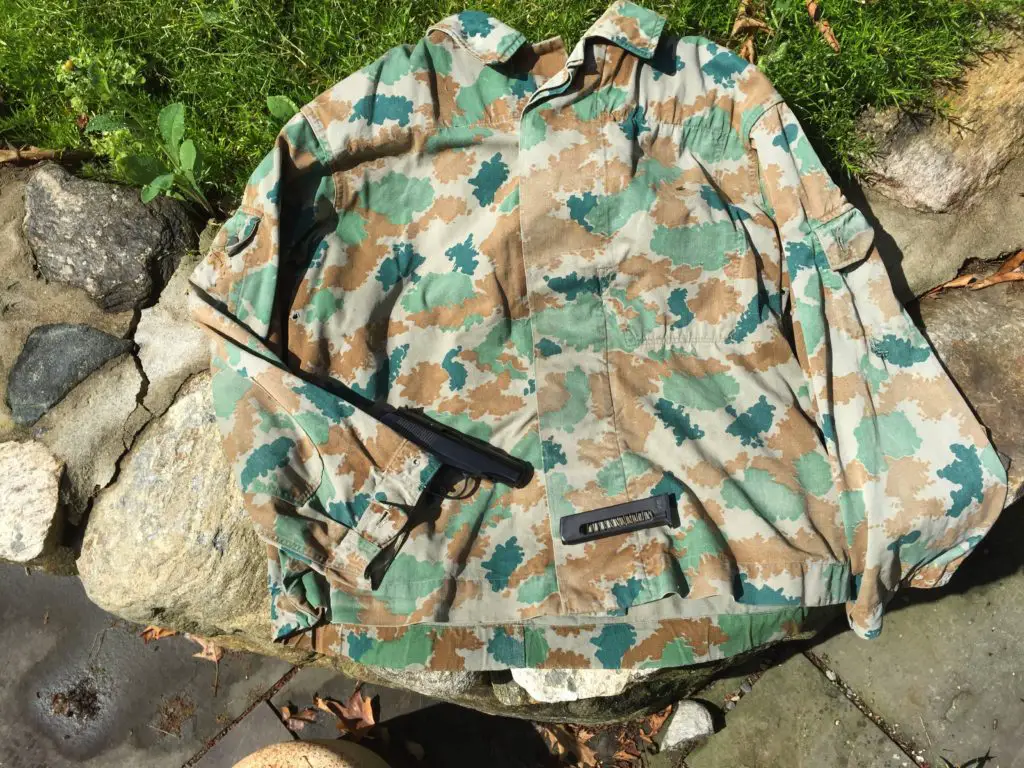
Same setup, a more squarely overhead shot. The “leaves” resemble that thematic device beloved of all Teutons, the oak leaf. Some originals of which can be seen in the background.
In 1953, the East Germans rose for one day, a rising driven by the announcement that everybody’s work quota was going up 10% to pay for this Army, and that they’d better be making quota by 30 June 53. Why that date? The birthdate of German Communist Walter Ulbricht had supplanted Hitler’s birthday as a national holiday, even though Ulbricht was little but the condom Stalin wore when he dealt with the Germans. The rising was spontaneous, disorganized, and suppressed brutally by the Soviet occupation army, the Group of Soviet Forces in Germany. The new NVA was not trusted to join the Soviets in shooting demonstrating workers; but an elite “police” force, modeled on the Waffen SS and led by former SS and Gestapo leaders, was.
It was only later that the Russians came to trust the NVA a little — although, always, with Soviet units behind them.
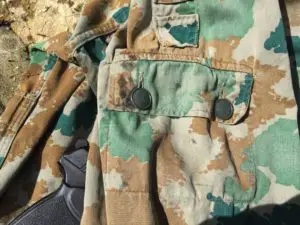
Close-up (all pictures embiggen) showing buttons on a sleeve pocket. These buttons are one-piece plastic moldings and very prone to breakage in the plastic attach loops. Note also the strong cotton twill material.
Later, they were permitted to make small modifications in their equipment, like the pebbled plastic stocks that distinguish East German AKs. But very little deviation from the Party Line — or the Soviet quartermaster catalog — was tolerated. When NATO was still quite fractious and bumptious and every nation still went its own way, its eastern equivalent, the Warsaw Pact, had unity of command and absolute interoperability of equipment — possible because it was a master-slave relationship, not an association of free states.
According to Camopedia, the first East German camouflage suits were direct copies (or perhaps, hand-me-down supplies) of wartime Soviet recon unit camo. This odd pattern, which seems to owe more to the blotches worn by US Marines but with a peculiarly German grey-blue palette, is described like this:
The M58 Flachtarnenmuster pattern was issued between 1956 and 1967 to units in the East German Army (NVA) and Ministry of Interior (MDI). Also known as Kartoffelmuster (potato camouflage) or Blumentarn (flower camouflage), the pattern generally consists of blue-green, olive green & brown ragged blotches on a field grey background. Several mild color variations have been documented, some of which may appear darker due to their having been coated in anti-gas chemicals (which also gave the fabric a waxy texture). Several types of jacket, trousers, field equipment, shelter half and hood/helmet cover were produced in this pattern.
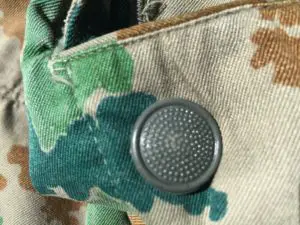
Slightly out of focus close-up of a button, also showing the twill material and the loose register of the camo print. Not bad, for over 50 years old.
After the East Germans retired these, they showed up everywhere from Angola to Vietnam, having been surplused to “fraternal socialist states and liberation movements.” We can’t remember whether we picked this one up in Europe or South America in the 80s or 90s.
The East Germans replaced it with a “rain pattern” uniform — the one in which Your Humble Blogger did a penetration test of US Army Europe HQ in Stuttgart-Vaihingen, proving for all time that all Germans do look alike to us Yanks. We’ve still got that suit, too.

Kevin was a former Special Forces weapons man (MOS 18B, before the 18 series, 11B with Skill Qualification Indicator of S). His focus was on weapons: their history, effects and employment. He started WeaponsMan.com in 2011 and operated it until he passed away in 2017. His work is being preserved here at the request of his family.

